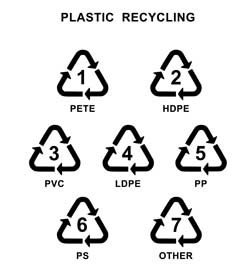
Plastic Bottles 101
How Much Do You Know about Plastic Bottles?
Choose Plastic Bottles Carefully to Prevent Chemicals in the Plastic from Leaching into Your Water. Consider Switching to the Good, Old-Fashion Glass Bottles or the Stainless-Steel Vacuum Bottles!

Humanity is using more and more plastics in the form of bottles every year. According to a news article published by the Christian Science Monitor, citing the Container Recycling Institute, in 1990 Americans bought 1.1 billion pounds of plastic, but in 2002, they bought more than three times that, 4 billion pounds! With our increasing use of plastic bottles to fill everything from water to beverages and food, how much do we know about them and their safety? Are these plastic bottles safe enough for us to fill them with pure filtered water and drink from them?
What are these plastic bottles? To answer this question, we have furnished a list of most commonly used plastic containers and bottles in the United States, as follows:
- #1 PET or PETE (polyethylene terephthalate)—This clear and tough plastic is often used in carbonated soft drinks (such as the 2-liter soda containers), juice, beer, mouthwash, peanut butter, salad dressing, and detergent and cleaner containers. Water is usually sold in #1 bottles not recommended for refills and considered for one-time use only. The problem with this type of plastic is that it leaches antimony trioxide, which has been shown to cause respiratory and skin irritation, menstrual problems and miscarriage in among, and slower mental development among children in the first 12 months of life, among other problems in people who have been exposed to this chemical over a long period of time. The longer a liquid is left in the #1 container, the higher the concentration of antimony trioxide released into the liquid.
- #2 HDPE (high-density polyethylene)—Plastic containers in this category include Tupperware, laundry detergent bottles, shampoo bottles, milk jugs, juice bottles, water containers, yogurt, and margarine tubs, cereal box liners, and generally harder and more opaque plastic bottles suitable for refills.





